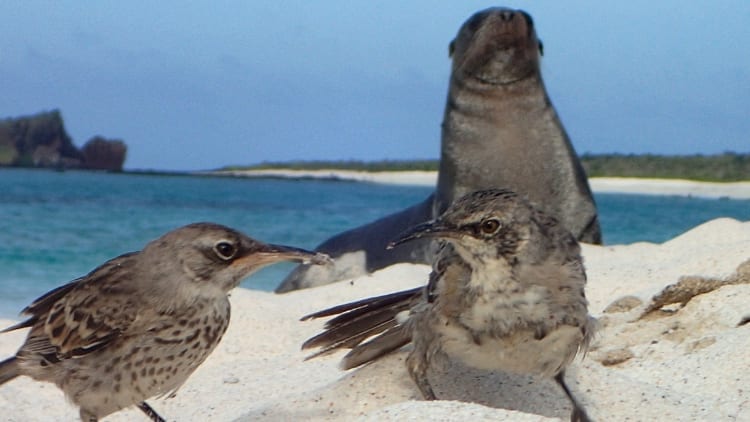“Extinct” Giant tortoise found after 100 years!
The Galápagos islands remain a pristine destination of discovery. A Giant tortoise, deemed to be extinct, has been found after more than one hundred years!...

No name in history is as closely associated with the Galápagos Islands as Darwin. In the archipelago you will find various statues, streets and even an island named after him. But who was Darwin and why does this strong bond exist with the “Islas Encantadas”? A short story about his discoveries, and the important influence of the forgotten mockingbird and Alfred Russell Wallace.
Charles Robert Darwin was born on February 12, 1809 in the trading town of Shrewsbury, England. The Darwin family had a prominent name in science; his grandfather Dr. Erasmus Darwin was a renowned botanist, and his father Dr. Robert W. Darwin was a doctor. His distinguished background gave him the opportunity to study at the University of Edinburgh and Christ’s College Cambridge. At the age of 22, shortly after his studies, he was given the opportunity to sail aboard the H.M.S. Beagle.
The ship was part of a new fleet of British research vessels (six in total) on which scientists and mathematicians travelled to study the world and create proper maps.
On September 15, 1835, Darwin arrived at the Galápagos Islands and the Beagle dropped anchor near the island of San Cristóbal. Darwin spent a total of five weeks in the archipelago. As a geologist, his main interest was in studying the volcanic landscape. He mainly collected species and plants for friends at home. In the first instance, he actually was rather sloppy at it; for example, most of his famous finches he brought on board were not labeled with information about their origin nor way of life.
Which islands did Darwin visit?
During this 5-week trip, Darwin only took brief notes and recorded observations. It was not until he left the islands, during the crossing towards Tahiti, that he had time to sort his collection of species, birds and plants and noticed that his finches were not the same. Upon returning home to England two years later (1837), John Gould (an established ornithologist) identified 12 different species of finches in Darwin’s collection. Along with the earlier identification of the mockingbird species and other findings that Darwin had made during his travels, the theory of evolution took further shape in Darwin’s mind..
“…by far the most remarkable feature in the natural history of this archipelago…is that the different islands to a considerable extent are inhabited by a different set of beings…I never dreamed that islands, about fifty or sixty miles apart, and most of them in sight of each other, formed of precisely the same rocks, placed under a quite similar climate, rising to a nearly equal height, would have been differently tenanted.” – Darwin, Journal of Researches (1839, now known as The Voyage of the Beagle)
Wallace was born in Usk, Monmouthshire. Unlike Darwin, Wallace came from a middle-class family and was forced to leave school at the age of 13 due to a lack of money. Curious and with a great interest in nature, he worked in the countryside and traveled to the Amazon to work as a naturalist. Intelligent and self-taught, he slowly made a name for himself among his colleagues, but remained a very modest man.
Why is he important in the context of Darwin and the theory of evolution? After his visit to the Amazon (from which he lost almost all of his findings and collections as the ship caught fire and was completely lost on its return home), Wallace left for present-day Indonesia. During his stay there, he developed the theory of natural selection. Before publication, however, he wanted to test his ideas with his mentor and example Darwin. In 1858 he sent his ideas to Darwin to ask his opinion and to help him publish his findings.
What he did not know was that Darwin had been developing the same theory in his mind for many years, but had not dared to publish due to the controversy with the Church that preached the religious creation of mankind by God. Darwin was shocked when he received the papers from Wallace. Fearing that Wallace would now take credit, Darwin was forced to act. Under pressure and with the help of his friends Sir Charles Lyell (geologist) and Joseph Dalton Hooker (botanist) they decided not to publish Wallace’s theory. Instead, the papers of both Darwin and Wallace were presented at a meeting of the Linnean Society on July 1, 1858. With better connections in the world of science, Darwin was generally seen as the founder of the theory of evolution; he established this recognition for eternity with the publication of his book one year later: “Origins of Species by means of natural selection”.
Theory about the origin and development of life. According to Charles Darwin, life evolves because organisms that are best adapted to their environment have the greatest chance of survival. In addition, Darwin stated that the reproductive success of an individual depends on its traits and that only the traits that best suit the environment are passed onto the next generation. As a result, species are constantly adapting and evolving and hence a variety of species is created on Earth.